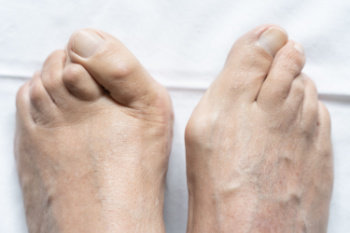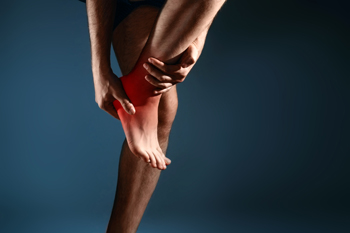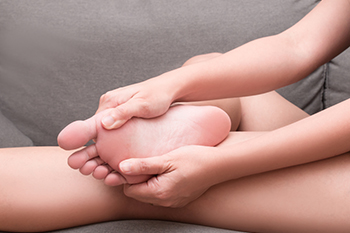Items filtered by date: February 2025
Symptoms and Causes of Bunions

Bunions are bony bumps that form at the base of the big toe, while the tip of the toe angles inward toward the other toes. This misalignment can lead to pain, swelling, and difficulty moving the toe. Symptoms often include redness, tenderness, and a visible bump at the joint. Risk factors for bunions include wearing tight, ill-fitting shoes, particularly high heels, which put pressure on the toes. Genetics can also play a role, as bunions often run in families. Other factors, such as arthritis or foot deformities, can increase the likelihood of developing bunions. To prevent bunions, it is important to wear shoes that fit properly, provide enough toe room, and offer proper arch support. Regularly stretching and strengthening the feet can also help reduce the risk of bunions and alleviate discomfort if they develop. If you have the beginning signs of a bunion, it is suggested that you consult a podiatrist who can offer you effective relief, and additional prevention strategies.
If you are suffering from bunion pain, contact Jack A. Sasiene, DPM of Texas. Our doctor can provide the care you need to keep you pain-free and on your feet.
What Is a Bunion?
Bunions are painful bony bumps that usually develop on the inside of the foot at the joint of the big toe. As the deformity increases over time, it may become painful to walk and wear shoes. Women are more likely to exacerbate existing bunions since they often wear tight, narrow shoes that shift their toes together. Bunion pain can be relieved by wearing wider shoes with enough room for the toes.
Causes
- Genetics – some people inherit feet that are more prone to bunion development
- Inflammatory Conditions - rheumatoid arthritis and polio may cause bunion development
Symptoms
- Redness and inflammation
- Pain and tenderness
- Callus or corns on the bump
- Restricted motion in the big toe
In order to diagnose your bunion, your podiatrist may ask about your medical history, symptoms, and general health. Your doctor might also order an x-ray to take a closer look at your feet. Nonsurgical treatment options include orthotics, padding, icing, changes in footwear, and medication. If nonsurgical treatments don’t alleviate your bunion pain, surgery may be necessary.
If you have any questions, please feel free to contact our office located in Lake Jackson, TX . We offer the newest diagnostic and treatment technologies for all your foot care needs.
Plantar Heel Pain in Middle Age and Beyond

Plantar heel pain becomes increasingly common in middle age and older adults due to years of wear and tear on the feet. The plantar fascia, a thick band of tissue supporting the arch, loses elasticity over time, making it more prone to microtears and inflammation. Conditions like plantar fasciitis and heel spurs often develop, leading to sharp, stabbing pain, especially during the first steps in the morning. Age-related changes such as reduced fat padding in the heel, decreased flexibility, and weakened foot muscles contribute to the problem. Standing for long periods of time during the day, excessive walking, or wearing unsupportive shoes can worsen symptoms. Maintaining foot health through wearing proper footwear, stretching, and orthotic support can help alleviate discomfort. If you have heel pain that persists or interferes with daily movement, it is suggested that you seek professional evaluation and treatment from a podiatrist.
Many people suffer from bouts of heel pain. For more information, contact Jack A. Sasiene, DPM of Texas. Our doctor can provide the care you need to keep you pain-free and on your feet.
Causes of Heel Pain
Heel pain is often associated with plantar fasciitis. The plantar fascia is a band of tissues that extends along the bottom of the foot. A rip or tear in this ligament can cause inflammation of the tissue.
Achilles tendonitis is another cause of heel pain. Inflammation of the Achilles tendon will cause pain from fractures and muscle tearing. Lack of flexibility is also another symptom.
Heel spurs are another cause of pain. When the tissues of the plantar fascia undergo a great deal of stress, it can lead to ligament separation from the heel bone, causing heel spurs.
Why Might Heel Pain Occur?
- Wearing ill-fitting shoes
- Wearing non-supportive shoes
- Weight change
- Excessive running
Treatments
Heel pain should be treated as soon as possible for immediate results. Keeping your feet in a stress-free environment will help. If you suffer from Achilles tendonitis or plantar fasciitis, applying ice will reduce the swelling. Stretching before an exercise like running will help the muscles. Using all these tips will help make heel pain a condition of the past.
If you have any questions, please feel free to contact our office located in Lake Jackson, TX . We offer the newest diagnostic and treatment technologies for all your foot care needs.
Choosing the Right Running Shoes for Different Terrains

Selecting the right running shoes for your intended terrain is essential for comfort, performance, and injury prevention. For road running, choose lightweight shoes with adequate cushioning to absorb impact on hard, flat surfaces. Look for breathable materials and a snug fit to prevent blisters during longer runs. Trail running requires sturdier shoes with rugged soles for better grip on uneven, rocky, or muddy terrain. Waterproof or water-resistant materials can keep your feet dry in wet conditions. For treadmill running, focus on shoes with shock absorption and flexibility to handle the repetitive motion. Always consider your foot type, such as flat feet or high arches, when choosing shoes to ensure proper support and alignment. Worn or inappropriate shoes can lead to discomfort or injury. For expert guidance on choosing the right running shoes for yourself, it is suggested that you see a podiatrist to ensure your footwear matches your running needs.
You should always make sure your running shoes fit properly in order to avoid injury. For more information, contact Jack A. Sasiene, DPM from Texas. Our doctor can provide the care you need to keep you pain-free and on your feet.
Choosing the Right Running Shoe for Your Foot Type
Improper shoe sizing can cause a myriad of problems for your feet. Shoes that don’t fit you properly can lead to muscular imbalances in your body, which can result in foot, knee, and hip injuries.
Tips for Finding the Right Running Shoe
- Make sure you have a thumb’s width of wiggle room between the end of your longest toe and the front of the shoe.
- There should be little to no slipping at the heel
- Don’t assume your size in one shoe brand will be your size in another
- Do not lace up your shoes too tightly
- Walk around in the store with your new shoes before you buy them
If you have any questions, please feel free to contact our office located in Lake Jackson, TX . We offer the newest diagnostic and treatment technologies for all your foot care needs.
Sesamoiditis Facts

Sesamoiditis is named after the sesamoid bones, which are small, pea-shaped bones embedded in tendons beneath the big toe joint. These bones act like pulleys, aiding movement and bearing weight. Sesamoiditis occurs when these bones or surrounding tendons become inflamed, often due to repetitive stress or overuse. It is common among athletes, dancers, and individuals who engage in activities requiring frequent toe pressure, such as running or jumping. People with high arches or those who wear high heels are also at a higher risk. Symptoms include pain beneath the big toe, swelling, and difficulty bearing weight. Left untreated, it may lead to chronic discomfort or restricted mobility. If you have this type of foot pain, it is suggested that you schedule an appointment with a podiatrist who can provide an accurate diagnosis and offer treatments like orthotics, activity modification, or in severe cases, surgery. Early care helps alleviate pain and prevent further damage.
Sesamoiditis is an unpleasant foot condition characterized by pain in the balls of the feet. If you think you’re struggling with sesamoiditis, contact Jack A. Sasiene, DPM of Texas. Our doctor will treat your condition thoroughly and effectively.
Sesamoiditis
Sesamoiditis is a condition of the foot that affects the ball of the foot. It is more common in younger people than it is in older people. It can also occur with people who have begun a new exercise program, since their bodies are adjusting to the new physical regimen. Pain may also be caused by the inflammation of tendons surrounding the bones. It is important to seek treatment in its early stages because if you ignore the pain, this condition can lead to more serious problems such as severe irritation and bone fractures.
Causes of Sesamoiditis
- Sudden increase in activity
- Increase in physically strenuous movement without a proper warm up or build up
- Foot structure: those who have smaller, bonier feet or those with a high arch may be more susceptible
Treatment for sesamoiditis is non-invasive and simple. Doctors may recommend a strict rest period where the patient forgoes most physical activity. This will help give the patient time to heal their feet through limited activity. For serious cases, it is best to speak with your doctor to determine a treatment option that will help your specific needs.
If you have any questions, please feel free to contact our office located in Lake Jackson, TX . We offer the newest diagnostic and treatment technologies for all your foot care needs.
